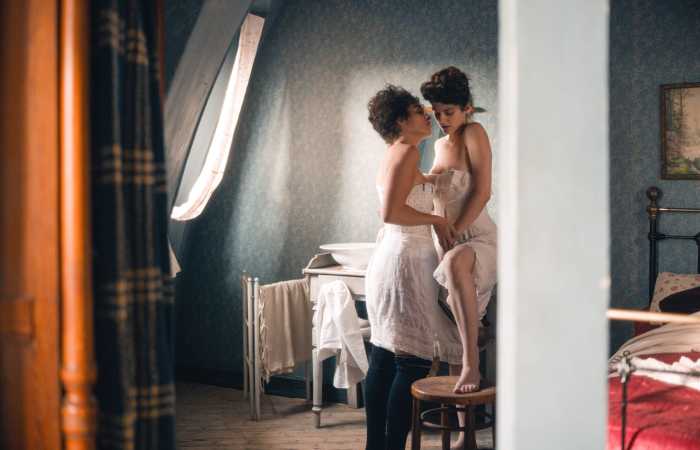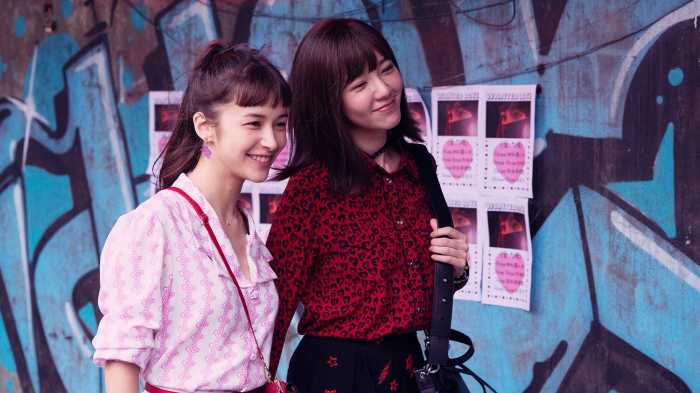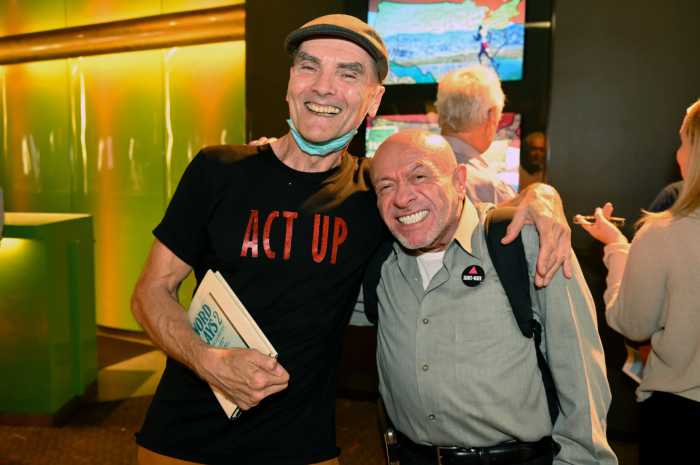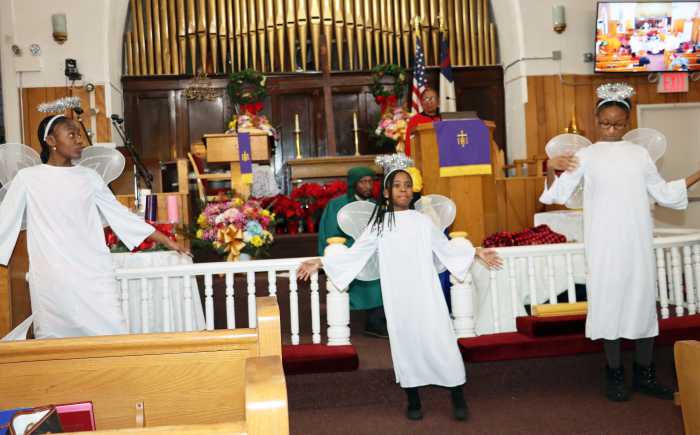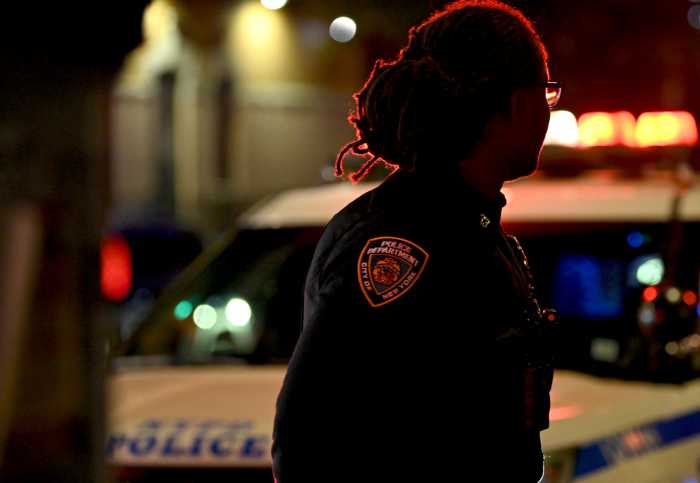Bisexual director Michelle Garza Cervera makes an auspicious feature film debut with the Mexican horror film “Huesera: The Bone Woman.” Valeria (an impressive Natalia Solián) and her husband Raúl (Alfonso Dosal) are excited when they find out they are pregnant. However, Valeria soon starts having strange experiences. She sees a neighbor jump out the window across the street — and yet, the broken body moves, then disappears. Did it happen, or was she hallucinating?
Valeria pays a visit to Ursula (Martha Claudia Moreno), a shaman, who might be able to help her, but she also has many bad feelings. She struggles when she babysits for her niece and nephew, sensing an intruder. And Valeria’s fragile mindset is not improved when she gets romantically involved with Octavia (Mayra Batalla), an ex-girlfriend.
“Huesera” conveys the anxiety of impending motherhood with all the doubts and discomfort Valeria experiences, and Cervera features striking visuals and a nifty sound design to give viewers an unsettling experience.
The filmmaker spoke with Gay City News about her new film.
I like the idea, expressed in the film, that motherhood “splits you into two people.” What prompted you to create this film and focus on the mental and physical ramifications of Valeria’s anxiety?
It was a very long and complex process to create the film and understanding how the entity had to work in the film. When I was growing up, there was a woman in my family who had made a decision similar to Valeria’s. I didn’t know her name or her story for years. When I was in my 30s, I started asking questions about her, and that’s when I learned her story. I wanted to tell the story of a woman who had made this decision, because that helps change people’s perspectives.
When you make such a big decision, you have to go through a painful process. What has to happen for her to get to that point? More than motherhood, when someone has to go within themself to find a deep truth, this other you within you had to come out, and that is super-painful. We got to that point with my cowriter (Abia Castillo). What is more visceral than a cracking bone? The idea that something cracks you profoundly until you accept that thing. That’s how we got to the idea of La Huesera, which is this entity that cracks you down until you find yourself, and then you reconstruct.
You create several layers in the film — past and present; real and imagined; every day and the occult; mental and physical. Can you talk about how you built the different worlds and realities?
The film is very personal. The seed of it was someone in my family, but it was personal to me and my cowriter. We have to show the world we inhabit in Mexico City. The middle-class world we inhabit has intense ideas and sanctified images of motherhood. We had to talk about this world we know — her family and her boyfriend — but she crosses into different worlds.
I was part of the punk scene, and more than the music, it changed my worldview. I compare it to the glasses in John Carpenter’s “They Live” — once you put on the glasses you can’t take them off or forget. We wanted Valeria to have this ex-girlfriend, and this world she tries to hide in the closet; she doesn’t want to go back to this. With punk, you question everything — why this and why this? — and you have ideas that give you a path in life. It’s very personal. I wanted to use the worlds I know to give details in the film and use that to build the world of the characters.
What can you explain about the spiritual/occult world presented in the film, which may be unfamiliar to American audiences?
The most important thing is I want women who go through Valeria’s process. Those women can be shaman or not. They are like witches. These women have been helpful for going through difficult processes. They have this knowledge that you will be fine. They are women who have been broken and have revealed themselves. I had an aunt who got me into shamanism and took me to cleanses. It was important for me to be truthful and build a particular world of shamanism for the film. To develop these witches, we used images of hyenas and vultures who eat flesh to compare them to the dark side of humanity. To me, they are animals that bring life to death. They use something that is dying to live. The actresses move and are inspired by these animals. It was magical filming those scenes with the witches. It was an intense shooting day and very spiritual and very symbolic for everybody.
Valeria is tough and strong but also vulnerable and scared. I found her trying to do the right thing and felt her frustration as her mind cracked. She is haunted for dropping a baby. She is chided for being aspirational. What decisions did you make about Valeria’s character?
It was important for Valeria to not be a victim. Also, it was important that she had to make a decision that was within herself. The arc is about her. I didn’t want it to be a violent family situation or because that she’s a lesbian. She tells her ex, “This is not about you.” She goes to deepest part of herself and liberates it. The actress is a mother, and we worked from that. We built her character based on her personal experiences of being a mom — the way she is very abrupt, and how she breaks things and how she acts with her husband.
I’m curious about her affair with Octavia and this idea of her having a feminine connection since she seems less inclined to have sex with her husband while pregnant. What can you reveal about her bisexuality?
Octavia was her best friend and lover growing up. In the punk world, or with political groups, you have very strong connection while changing your world view. You have strong lasting connections; she knew Valeria perfectly. In the flashback, she is the only person who understands the bone cracking and doesn’t scold her about it. I worked with the actresses on this. When they are having sex, or together, Octavia is the only character who embraces Valeria’s anxiety and doesn’t try to contain her. She wants her to take this particularity of self and make it pleasurable. You have to look to this past part of your life to understand your present or future.
The film is ambiguous in parts — how much is in her head? What is real? How do you want viewers to read your film?
It was such a discussion. For us, it was important that La Huesera was real for Valeria. She sees her, she feels her, she breaks her down. To us, La Huesera exists. We never wanted to make it feel like it was a dream. When she is feeling it, we have to believe her, and see it from her eyes.
The visual and sound design of the film is impressive, from shots that mirror or split the action to sounds of bones cracking to sequences like one in a forest that suggest the psychology of Valeria. Can you discuss your approach to the material?
There were two basic aesthetic constants — bone cracking and spiderwebs. The mirrors were used to split the personality. With the cinematographer, sound designer, and the musicians, we worked with these rules. There are many webs throughout the film. There are many weavings and repetitions of sounds. We wanted to create a world that is very colorful, with many primary colors — it is not dark — but we had to build the sense of a spider web, so she feels more and more imprisoned. We were afraid it would be too subtle. And what gives you more cringe than the sound of cracking bone? It was amazing to have this specific element to relate to something emotional the character is going through. We recorded people who crack themselves. Every time we had a chance to crack something, like the chicken, we used it. We found more ways to add more bones.
Likewise, your film is more supernatural than scary. Can you talk about building the tension and creating the sense of unease?
For us it was super important to have a constant feeling that there is something wrong. There is nothing scarier than when the familiar turning strange. Valeria has a life where everything is OK. Her husband is nice. But when you start feeling the family doesn’t feel OK, there is a sense of unease and that something terrible is going to happen.
“Huesera: The Bone Woman” | Directed by Michelle Garza Cervera | Opening February 10 at the Manhattan Alamo in NYC and available on VOD February 16 | Distributed by XYZ Films


